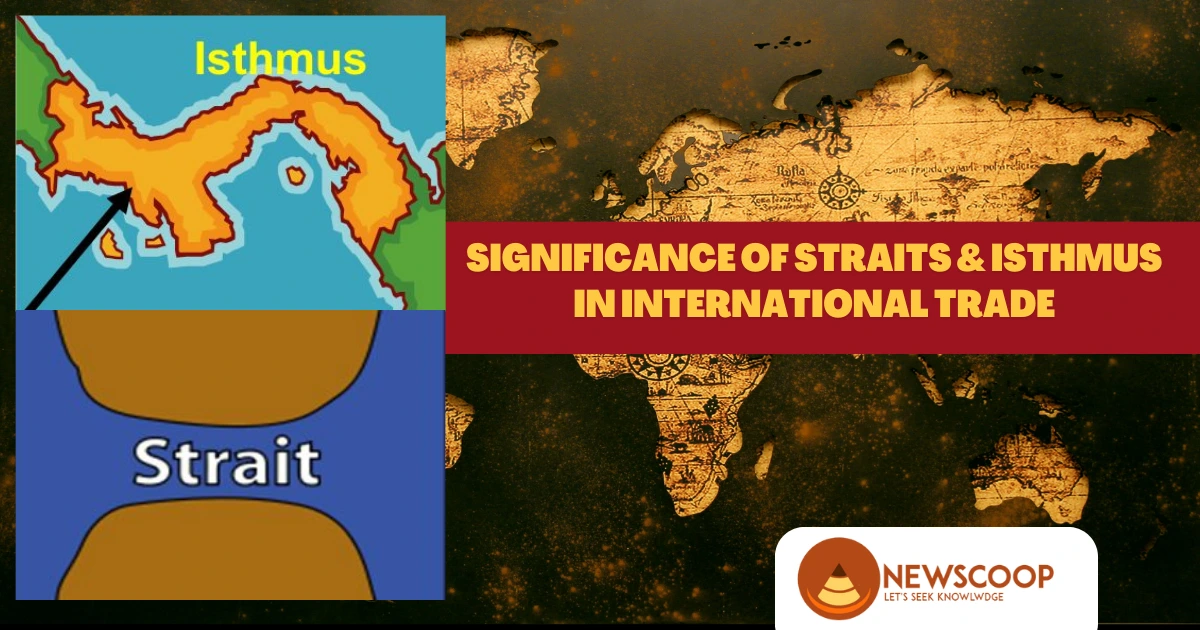In the world of global commerce, the strategic geographical characteristics of straits and isthmuses play a vital role in shaping international trade routes and driving economic growth. These natural features, often narrow passages of land or water, have been instrumental in facilitating maritime trade, influencing geopolitical relationships, and fostering economic development.
In this article, we will explore the significance of straits and isthmuses in international trade, examining their historical significance, contemporary relevance, and the geopolitical implications they encompass.
What is Strait?
A strait is a narrow waterway that connects two larger bodies of water, such as seas or oceans, allowing for the passage of ships and maritime traffic. Straits can be natural, formed by geological processes, or they can be artificially created by humans for navigational purposes.
Examples of Strait
- Strait of Hormuz: Connects the Persian Gulf to the Gulf of Oman.
- Strait of Malacca: Connects the Pacific Ocean to the Indian Ocean.
- Strait of Gibraltar: Connects the Mediterranean Sea to the Atlantic Ocean.
- Bering Strait: Connects the Arctic Ocean to the Bering Sea.
- Palk Strait: Connects the Bay of Bengal to the Gulf of Mannar.
What is Isthmus?
An isthmus is a narrow strip of land that connects two larger land masses, separating two bodies of water. It serves as a natural bridge or link between larger land areas.
Examples of Isthmus
- Isthmus of Panama: Connecting North and South America.
- Isthmus of Corinth: Connecting the Peloponnese peninsula to mainland Greece.
- Kra Isthmus: Connecting the Malay Peninsula to mainland Asia.
- Isthmus of Tehuantepec: Connecting the Gulf of Mexico to the Pacific Ocean.
- Isthmus of Suez: Connecting the Mediterranean Sea to the Red Sea.
Historical Significance of Straits & Isthmus in International Trade
Certainly, there are the historical significances of straits and isthmuses in international trade:
- Silk Road and Incense Route: These ancient trade routes acted as early versions of interconnected trade routes, facilitating the exchange of goods, culture, and ideas between regions. While not straits or isthmuses, they laid the foundation for recognizing the value of connected trade routes.
- Construction of the Panama Canal: The Isthmus of Panama’s significance lies in the construction of the Panama Canal. This engineering marvel revolutionized global trade by providing a direct water route between the Atlantic and Pacific Oceans, reducing transit times and costs for maritime commerce.
- Suez Canal’s Impact on European-Asian Trade: The Isthmus of Suez, connecting the Mediterranean Sea to the Red Sea, was historically crossed by land or circumnavigated around Africa. The construction of the Suez Canal in the 19th century dramatically shortened the maritime journey between Europe and Asia, increasing trade efficiency.
- Isthmus of Corinth and Corinth Canal: In ancient Greece, the Isthmus of Corinth presented a significant barrier to trade and travel between the Aegean Sea and the Ionian Sea. The construction of the Corinth Canal in the late 19th century further facilitated maritime trade by providing a direct water route through the isthmus.
- Potential Impact of the Kra Isthmus Canal: The Kra Isthmus, connecting the Malay Peninsula to mainland Asia, has been considered for canal projects similar to the Panama Canal. If realized, this canal could reduce shipping distances between the Indian Ocean and the South China Sea, significantly influencing global trade patterns.
Modern Significance of Straits & Isthmus in International Trade
- Energy Security through Control of Critical Waterways: Straits like the Strait of Hormuz are pivotal for global energy security. Control of these passages allows nations to influence the flow of oil and gas, impacting the world economy and energy markets.
- Major Economic Hubs and Ports: Cities located near straits and isthmuses often serve as major economic hubs. Ports in cities like Singapore, Rotterdam (Netherlands), and Panama City (Panama) are crucial for global trade, handling vast amounts of cargo.
- Geopolitical Influence and Strategic Importance: Control over key straits and isthmuses can confer significant geopolitical advantages. Nations vie for influence in regions like the Strait of Malacca and the South China Sea due to their critical role in trade and navigation.
- Alternative Trade Routes and Connectivity: The use of straits and isthmuses provides alternative trade routes, reducing dependence on longer and potentially riskier routes. This diversification of routes enhances trade resilience and flexibility.
- Environmental Considerations and Challenges: Environmental concerns arise from the impact of canal construction, pollution in high-traffic straits, and the vulnerability of narrow points to climate change-related sea-level rise. Sustainable practices and conservation efforts are vital for maintaining these vital passages.
Also Read: Important Hills of India
Conclusion
In conclusion, the significance of straits and isthmuses in international trade is immense. These natural features, be they waterways or land bridges, have shaped global commerce from ancient trade routes to modern canal systems. They influence energy security, drive economic hubs, and hold geopolitical importance.
However, they also pose environmental challenges. Recognizing their ongoing relevance, we must prioritize sustainable trade practices for the benefit of future generations.
Thank You!





